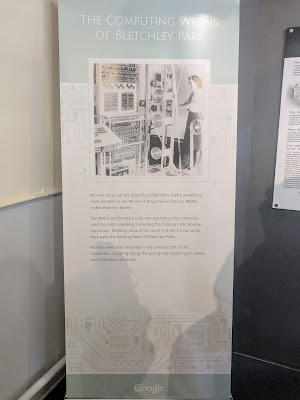Our trip to Bletchley Park was the one that I was most looking forward to, having a vague idea about the covert activities that occurred there during the Second World War thanks to shows like The Bletchley Circle and movies like the Imitation Game (which takes bold creative liberties, it turns out).
We were there to see the National Museum of Computing, which is actually a separate entity from Bletchley Park though they share a space and a history. The location was chosen because it is only a train ride away from London without being conspicuously close.
Sheridan was a lively and engaging guide, helping to break down complex ideas into understandable bites using useful analogies. He did a good job of promoting the role women played at Bletchley Park, stating that it was 4-1 women to men at the facility. The museum has made efforts it seems to tell the stories of women who worked here, using pop-up display posters like the one shown in the photograph below to talk about the Wrens (Women's Royal Naval Service). While the museum still has a male-heavy history it is good to see efforts to remediate this.
While this tour was interesting and I was glad to get an opportunity to wander around the beautiful grounds of Bletchley Park and to visit their WWII codebreaking museum, we did not see or hear about either buildings' library or archive. This was disappointing as I'm sure they have plenty that would have interested a group of LIS professionals. As it stands, it was a good day trip out of London and an interesting opportunity to learn about a topic I know very little about.








Comments
Post a Comment